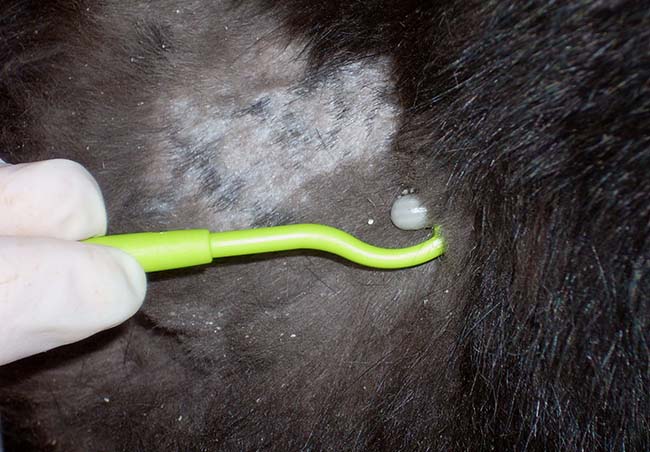11 Jan 2022
Tick control in dogs – risk-based approach and owner engagement

Figure 1. Engorged female Ixodes ricinus ticks.
Tick-borne disease represents an increasing risk to UK dogs and their owners. This threat comes not just from Lyme disease endemic in the UK, but also from other tick-borne diseases originating abroad.
As both the incidence of Lyme disease in the UK and the frequency of pet imports increase, so will the risks of tick-borne disease. Dogs at high risk of exposure therefore need adequate preventive measures put in place against tick exposure and tick-borne disease.
The challenge for veterinary professionals is twofold – how to assess which dogs are at risk, then how to engage with pet owners to ensure preventive measures are carried out.
Tick-borne disease represents an ongoing and growing risk to UK pets and their owners. This comes from increasing numbers of endemic ticks, newly introduced tick-borne pathogens and exotic ticks entering the country.
The most common ticks found on UK dogs and cats continue to be Ixodes species. These ticks can transmit a wide range of pathogens, including Borrelia species and tick-borne encephalitis virus (TBEV).
Dermacentor reticulatus is also present in endemic foci in Wales, and south-west and south-east England. These foci present an opportunity for Babesia canis to establish in these areas, which was demonstrated with an outbreak of canine babesiosis in Harlow, Essex.
Rhipicephalus sanguineus is a tick capable of transmitting a variety of tick-borne pathogens, including rickettsial diseases with zoonotic potential. It is not endemic in the UK, but increased pet importation makes the establishment of R sanguineus infestation in homes more likely.
The potential for exposure to these ticks – and the pathogens they carry – means dogs at high risk of exposure should have tick preventive measures in place.
The challenge for veterinary professionals is twofold – how to assess which dogs are at risk, then how to engage with pet owners to ensure preventive measures are carried out. Risk, lifestyle factors, and geographic distribution of these ticks and pathogens need to be considered.
Ixodes ticks and Lyme disease
The most common tick-borne pathogen of veterinary significance to UK dogs is Borrelia burgdorferi, the cause of Lyme disease.
Lyme disease also has zoonotic potential and continues to have high public awareness. As a result, veterinary professionals are likely to face enquiries regarding the risk Lyme disease poses, both to pets and their owners.
Dogs across the country are at risk of exposure to infection via infected Ixodes ticks. Studies have shown areas of higher tick density, however, where the risk of exposure will be much higher. Examples include Thetford Forest, the New Forest, Lake District, Yorkshire Dales, Scottish Highlands, the Quantock Hills and the Mendip Hills (Abdullah et al, 2016).
Ticks are also more active during the spring, summer and autumn, which increases exposure risk (Wright et al, 2018). Exposure, however, can take place at any time of year, with tick activity occurring at temperatures as low as 4°C.
Although B burgdorferi complex has been reported in a variety of mammals, dogs and humans seem relatively more susceptible to disease. Where B burgdorferi is endemic, it is maintained by reservoir hosts that are subclinical carriers of infection, and transport hosts that do not carry infection, but maintain populations of infected ticks. Small rodents and birds act as reservoir hosts, whereas ruminants and deer – especially roe deer – act as epidemiologically important transport hosts.
Risk of exposure to infected ticks is, therefore, much higher for dogs walking in pasture shared by deer and livestock, in long grass where ticks quest, and undergrowth such as bracken.
Ticks become infected mostly as larvae then remain infected as nymphs and adults. Nymphs are thought to be more significant in terms of overall transmission than adults as they are more abundant than adults, and due to their size less likely to be groomed off pets and missed on examination.
Lyme disease in the human UK population is increasing, with 1.94 laboratory confirmed cases per 100,000 people in England and Wales in 2016 rising to 2.7 in 2017. A recent paper looking at retrospective GP records on Lyme disease diagnosis suggests these figures are a significant underestimate of the true total (Cairns et al, 2019).
The growing number of reported cases is likely to be a combination of a genuine increase in pathogen transmission, heightened awareness among the general public and increased surveillance. A number of factors are likely to be driving increased human exposure to ticks, including increased outdoor recreational activity, increased forestation and green space, increased numbers of deer and potential reservoir hosts, and an increased seasonal duration of tick activity. These factors are also likely to drive increased exposure in dogs.
However, data concerning the incidence of Lyme disease and prevalence of Borrelia species in UK dogs is lacking. No official recording of laboratory confirmed Lyme diseases cases exists, as it does for humans, and no large‑scale peer review studies have been carried out in the past 20 years.
Canine exposure to Borrelia species is, however, increasing. Two large studies have examined the distribution and prevalence of ticks infesting domestic dogs, as well as the prevalence of B burgdorferi in these ticks (Smith et al, 2012; Abdullah et al, 2016). The prevalence of Borrelia species found in Ixodes ticks attached to dogs has only increased marginally – from 2.3 per cent to 2.37 per cent – in the time between the two studies, but the overall number of ticks has increased. This suggests dogs are being exposed to increased numbers of Borrelia-infected ticks, but research is still required to establish how this is translating into infection and disease.
In the meantime, the need for tick and Lyme disease prevention should be based on lifestyle risk factors.
TBEV
Ixodes ricinus (Figure 1) is also a vector for TBEV, which can cause a potentially fatal neurological disease known as TBE in humans and, less commonly, dogs.

The European subtype of the virus has rapidly spread across central and western Europe in recent years, where it is maintained in endemic foci. In endemic areas, the prevalence of TBEV in questing ticks rarely exceeds one per cent, even where human incidence of disease is high (Imhoff et al, 2015).
The risk of human and canine infection from short visits to endemic areas with limited tick exposure is, therefore, low; however, people and pets living, frequently visiting or working in endemic areas would be at significantly greater risk of exposure over time.
Rodents act as reservoir hosts capable of maintaining the pathogen once it has moved to a new area. Larger wild animals – such as deer – are not considered to be competent hosts for virus transmission, but serve as transport hosts for infected ticks. These transport hosts – and migratory birds – have played a significant role in carrying infected ticks over large distances, including into the UK.
A surveillance programme carried out by Public Health England in 2018 found 4 per cent of UK deer samples to be serology positive for TBEV, with foci in the New Forest and Thetford Forest. The Thetford Forest area had the highest proportion (47.7 per cent) of seropositive samples, with a tick also confirmed positive for TBEV by PCR (Holding et al, 2020).
This is strong evidence for TBEV being endemic in at least one endemic focus in the UK, and possibly more.
The risk to dogs and their owners from these UK foci are low, and should be kept in perspective for worried pet owners; however, tick protection for pets and public alike visiting these areas is important to minimise the risk, as is ongoing surveillance as further spread through the endemic Ixodes tick population and rodent reservoirs is likely.
D reticulatus and B canis
D reticulatus ticks are the European vector for B canis, a cause of potentially fatal haemolytic anaemia and thrombocytopenia in dogs.
The distribution of B canis is closely linked with D reticulatus, and both are increasing their range and prevalence across Europe (Figure 2).

Field surveys conducted in England and Wales during 2009-16 confirmed the presence of D reticulatus in four main areas: western Wales, north Devon, south Devon and Essex.
Most of the land known to be inhabited by D reticulatus in the UK is sand dunes, which differ from the meadow and pasture they more commonly inhabit in Europe. The Essex population is, so far, unique in the UK in that it is neither coastal nor in the proximity of dune systems.
The establishment of an endemic focus of B canis in Essex – and an infected tick being found to be positive in the Welsh foci of D reticulatus ticks – demonstrates the potential for B canis to establish and spread in the UK.
Vigilance for relevant clinical signs of babesiosis is therefore important in dogs entering the UK from abroad, and tick prevention measures should be considered for dogs with access to fields and coastal areas in Essex, as well as known endemic areas for D reticulatus.
R sanguineus
R sanguineus is not endemic in the UK, as the climate is currently not favourable for establishment of an endemic population; however, it is endemic in southern and eastern Europe, and moving northwards (Figure 3).

It has the potential to complete its life cycle more quickly than Ixodes ticks, and larvae, nymphs and adults will all feed on pets and humans. This allows it to establish in households in a similar way to fleas.
The author is aware of at least three cases of house infestation, introduced by dogs imported from Spain, Greece and Africa.
Additionally to the potential for house infestation, R sanguineus carries a number of tick-borne pathogens of veterinary and/or zoonotic significance, including Ehrlichia canis, Hepatozoon canis, Anaplasma platys and Rickettsia conorii (a zoonosis causing Mediterranean spotted fever).
Tick preventive measures are therefore crucial for dogs travelling abroad or being imported into the UK.
Prevention of tick exposure and tick-borne disease in dogs
Any dog with outdoor access may be exposed to ticks. Some pets, however, will be at considerably higher risk of exposure based on lifestyle; therefore, a risk assessment should be made to establish if tick prevention is required in an individual pet.
Several factors should be considered:
Q Are dogs walked on pasture shared by ruminants or deer?
Deer and ruminants are reproductive reservoirs for Ixodes ticks – especially I ricinus – with the potential for individual animals to carry very large numbers of ticks.
Q Do dogs walk on land containing tall grass or bracken?
These areas provide questing sites for ticks.
Q Do cats and dogs visit known geographic areas of high tick density?
The Big Tick Project, looking at the prevalence of ticks on pet dogs, confirmed previously recognised tick density patterns in the UK, although discrepancies arose, such as the apparent absence of ticks from parts of the Scottish Highlands. This could be explained by the lack of participating veterinary practices in these areas.
The Big Tick Project website allows the number of ticks found in a local geographic area to be checked by postcode. The recording and publicising of ticks found in practice is also useful via websites and social media to help pet owners and veterinary practices assess local geographic risk.
The Tick Surveillance Scheme also records geographic data from where ticks are submitted (Wright et al, 2018).
Q Do dogs live in or visit Essex, adjoining counties, Thetford Forest or the New Forest?
Those that do should be considered at higher risk of B canis and TBEV exposure, respectively.
Q Has the dog had ticks before?
Previous exposure means lifestyle is likely to expose the dog again in the future.
Q Has the pet been imported or travelled abroad?
These pets should be treated and checked for ticks to reduce the risk of exotic tick introduction and foreign pathogen exposure.
Preventive strategy measures
If, after risk assessment, it is decided preventive strategies are required then the following measures should be considered:
Preventive tick treatments
The use of prophylactic compounds that rapidly kill or repel ticks are useful in reducing tick feeding and, therefore, transmission of infection.
Products containing an isoxazoline, permethrin, deltamethrin and flumethrin all fulfil these criteria.
It is important to consider compliance when discussing which product to use, as well as lifestyle. Whether a client prefers – or is able to administer – a tablet, collar or spot‑on should be established, as well as whether the pet has had reactions to products in the past. Frequent swimming or bathing may make some topical products unsuitable.
It should also be remembered that no product is 100 per cent effective and owners should still be advised to check their pet for ticks at least every 24 hours if possible.
Checking for ticks every at least every 24 hours
Latest Tick Surveillance Scheme data suggests the majority of ticks are located and found around the head, face, legs and ventrum (Wright et al, 2018).
Nymphs are extremely small and easily missed, so tick removal alone should not be relied on for high-risk cats and dogs (Figure 4).

Ticks should be removed with a tick removal device (Figure 5) or fine-pointed tweezers. If tweezers are used, the tick should be removed with a smooth upward pulling action. If a tick hook is used then a simple “twist and pull” action is employed.

After ticks have been removed, they can be submitted to the Tick Surveillance Scheme for identification. Ticks should be placed in a container with a secure lid, and sent in an envelope marked “biological sample” to:
Tick Surveillance Scheme
Public Health England
Porton Down
Salisbury
Wiltshire
SP4 0JG
The University of Bristol also has an excellent tick identification website.
Vaccination
A licensed vaccine is available for Lyme disease prevention. The vaccine prevents migration of the spirochete to the salivary glands, reducing the risk of infection as a result.
In Europe, two vaccines for TBEV are licensed for human use, but neither has been licensed for dogs. Off-licence studies in dogs have shown some efficacy, but further safety and efficacy studies are needed before they could be routinely used.
Sticking to paths
Where possible, sticking to paths will greatly reduce the risk of tick exposure.
Engagement with owners
Having established which dogs are at high risk and that preventive measures are required, engagement with clients to ensure tick prevention is put in place is essential.
Recognising the value of treatments, cost and remembering to administer them are all barriers to effective compliance and control.
Recognising value
A risk assessment with clients and explaining the reasoning behind the decision to use a preventive treatment is an engaging exercise in itself, and will hopefully emphasise to clients the importance of the treatment being recommended.
Sales of parasiticides without explanation can lead to disenfranchisement – and even if products are bought, they may not be used.
Routine testing for Borrelia in high‑risk areas and testing dogs for tick-borne diseases with relevant clinical signs are vital for surveillance and owner awareness.
Highlighting positive cases on practice websites and social media will help raise awareness of regional risk. Use of social media, waiting room posters and practice websites are useful to educate owners, with information taking the form of diagrams, videos and infographics.
Checking for ticks routinely as part of health exams – and demonstrating how to remove them – will also help to demonstrate to owners that ticks are present and easy to miss. Public Health England has posters of ticks demonstrating how small nymphs and larvae are, and how easy they are to miss on physical examination.
Cost
Cost can be a barrier to clients buying appropriate treatments and may drive them towards buying cheaper products through alternative channels, where advice on their use may be limited.
Cost can be reduced though the use of practice plans, discounts for regular use or other schemes for spreading the cost of purchase.
Emphasising the cost of treating potential disease for unprotected high-risk dogs compared with the predictable spread cost of routine treatments is also worthwhile.
Compliance
Compliance can be increased by avoiding the use of technical/medical terms and Latin names for parasites.
A simple description is often more effective, and the use of diagrams and pictures to explain life cycles enables clients to understand the need for different stages of prevention.
Establishing preference for spot-on, tablet or collar preparations will encourage clients to use preventive products and increase the likelihood of them being administered correctly.
Demonstrating how to apply products in practice is also helpful in improving correct usage. Reminder alerts by text message, email or app will aid in reminding clients when to administer treatments.
Conclusions
Tick-borne diseases are a growing threat to UK pets, both in terms of increased potential exposure to ticks and from increased pet importation.
While effective treatment and control measures are available, increasing awareness of these diseases, surveillance, and identification of pets and owners at high risk of exposure remains vital if tick-borne disease is to be avoided.
A risk-based approach to tick-borne disease control will engage clients, while aids to help pet owners understand risk, apply treatments and remember when they are due will help to improve compliance.
